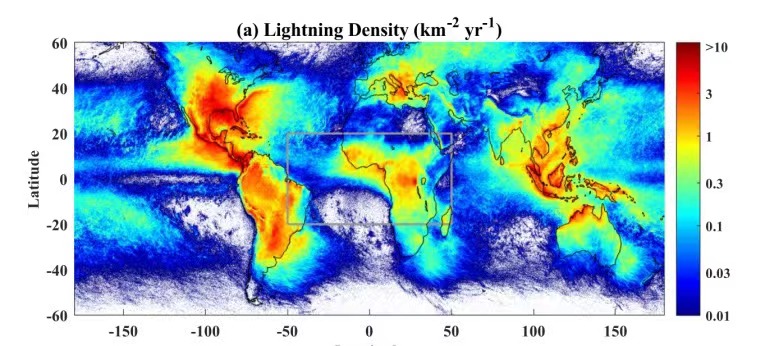
Lightning over tropical oceans is much less than on land.
· Coarse salt particles from the ocean can reduce lightning activity by weakening intra-cloud convection.
What is the difference in lightning between continents and oceans?
It has been found that, despite similar meteorological conditions, lightning strikes generally occur much less frequently on tropical oceans than on land. In other words, lightning was unevenly distributed between the two regions, but it was unclear what caused this significant difference.
At 23:00 on August 2, a study published online in "Nature Communications" pointed out that the salt in ocean droplets may be an important cause. It reduces the lightning activity of thunderstorms at sea, resulting in lower lightning levels over tropical oceans than over land.
The research was completed by Professor Daniel Rosenfeld of the Hebrew University of Israel, Professor Gong Wei of the State Key Laboratory of Surveying, Mapping and Remote Sensing Information Engineering of Wuhan University, and Professor Zhu Yannian of the School of Atmospheric Sciences of Nanjing University.
Daniel Rosenfeld and colleagues analyzed weather, aerosol and lightning activity data from 2013 to 2017 in Africa and its adjacent oceans (between 50°W and 50°E and 20°S and 20°N).
The authors believe the results help us understand the uneven distribution of lightning over land and sea and its impact on climate.
Previous research has shown that, given rainfall, fine-particle aerosols can significantly increase lightning frequency.
But for the first time, Daniel Rosenfeld et al. have found that coarse sea salt with a radius of more than 1 micrometer has the opposite effect.
These studies probe the secrets about the differences between continental and oceanic lightning and contribute to the understanding of lightning and aerosol-cloud-precipitation interaction mechanisms and their climate effects.
· Coarse salt particles from the ocean can reduce lightning activity by weakening intra-cloud convection.
What is the difference in lightning between continents and oceans?
It has been found that, despite similar meteorological conditions, lightning strikes generally occur much less frequently on tropical oceans than on land. In other words, lightning was unevenly distributed between the two regions, but it was unclear what caused this significant difference.
At 23:00 on August 2, a study published online in "Nature Communications" pointed out that the salt in ocean droplets may be an important cause. It reduces the lightning activity of thunderstorms at sea, resulting in lower lightning levels over tropical oceans than over land.
The research was completed by Professor Daniel Rosenfeld of the Hebrew University of Israel, Professor Gong Wei of the State Key Laboratory of Surveying, Mapping and Remote Sensing Information Engineering of Wuhan University, and Professor Zhu Yannian of the School of Atmospheric Sciences of Nanjing University.
Daniel Rosenfeld and colleagues analyzed weather, aerosol and lightning activity data from 2013 to 2017 in Africa and its adjacent oceans (between 50°W and 50°E and 20°S and 20°N).

Global distribution of lightning density from 2013 to 2017
The researchers found that coarse-particle marine aerosols, such as salt, can reduce lightning frequencies, while fine-particle aerosols can promote cloud electrification. Coarse salt particles from ocean droplets can reduce lightning activity by weakening intra-cloud convection. These larger particles can encourage warm rain to fall before the cloud water rises and reaches the necessary level of subcooling. And supercooling is a necessary step for cloud electrification.The authors believe the results help us understand the uneven distribution of lightning over land and sea and its impact on climate.
Previous research has shown that, given rainfall, fine-particle aerosols can significantly increase lightning frequency.
But for the first time, Daniel Rosenfeld et al. have found that coarse sea salt with a radius of more than 1 micrometer has the opposite effect.
These studies probe the secrets about the differences between continental and oceanic lightning and contribute to the understanding of lightning and aerosol-cloud-precipitation interaction mechanisms and their climate effects.
Related Posts
0 Comments
Write A Comments